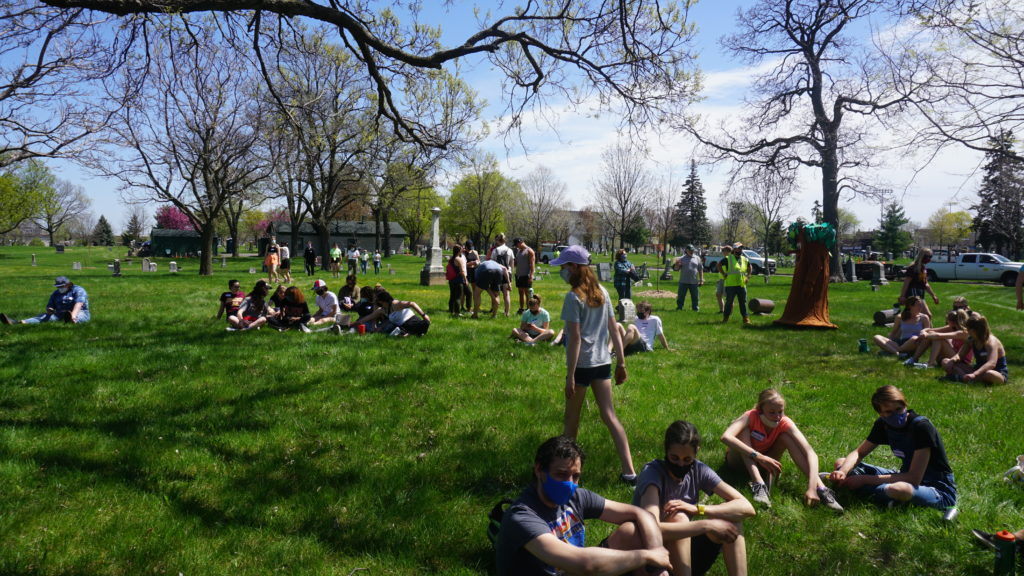TALES FROM PIONEERS AND SOLDIERS MEMORIAL CEMETERY
187th IN A SERIES
By OLGA ACUNA

What began as a class project addressing environmental injustice in the East Phillips neighborhood steadily flourished into an Arbor Day celebration at the notable Pioneers and Soldiers Memorial Cemetery on the intersection of Cedar Ave and Lake St. On Saturday May 1st, over 60 volunteers from the surrounding community gathered at the cemetery to aid in the planting of over 50 trees throughout the 27 acres of green space.
On one of the warmest days of the Spring season, this resilient intergenerational group of volunteers worked through the heat together to nurture the Earth by planting trees with help from arborists from the Minneapolis Parks and Recreation. Volunteers later gathered around for an ethereal blessing of the tree performance which included two deer puppets, bells, and poetry all done by the Semilla Center for Healing and the Arts. The event rounded off with the enjoyment of a collective meal in the shade with food from Pham”™s Rice Bowl. Volunteers mingled with one another, took photos with Elmer the Elm Tree, and watched out for an appearance from Fern and Lily, the local cemetery deer.
One participant commented on the event saying, “It was powerful to be in this neighborhood that was so impacted by the uprising after George Floyd’s murder and to do something meaningful. When I visit these trees in the future, it will help me remember the awfulness of police brutality in our state but also help me connect to the hope there is in the community.” Another, an 11-year-old, stated, “I’m scared of climate change and I know planting trees helps. Thank you!”

Open Spaces and Healing Initiative arose from the grand challenge course offered at the University of Minnesota, Innovation for the Public Good: Design for a Disrupted World. In this project-based course, students worked in interdisciplinary teams to develop entrepreneurial responses to current complex social and environmental problems. Classmates Olga Acuna, Sage Brinton, and Bemnet Kika, along with two other students, felt the need to address the pressing issue of environmental racism occurring in the East Phillips Neighborhood of South Minneapolis.
For over 80 years, the community of East Phillips has been exposed to a disproportionate amount of toxic waste from a myriad of pollution sources, including: arsenical pesticide facilities, land recycling sites, garbage incinerators, oil facilities, major traffic, and more. Studies done by the Minnesota Department of Health conclude the community now deals with the highest rates of asthma and lead poisoning hospitalizations in the State of Minnesota due to air pollution from nearby facilities. The Open Spaces and Healing initiative aims to activate green spaces in urban neighborhoods by implementing trees and benches. Trees have the power to filter atmospheric pollutants while also being able to cool the space down. The benches increase the amount of time a user spends in the space and increases accessibility. Numerous studies have proven the health benefits of spending time outdoors. Studies done by the the World Health Organization Europe explain that urban green spaces promote mental and physical health, and reduce morbidity and mortality in urban residents by providing psychological relaxation and stress alleviation, support physical activity, increase social capital within the community, and reduce exposure to air and noise pollution, and excessive heat. Our hope is to invite people into the space so that they can continue to find it as a place of tranquility within the busy streets of Minneapolis.
Spending time in a cemetery can seem macabre and taboo. However, as cities increase in density the number of urban green spaces decreases. Activating open spaces becomes vital for the well being of the community. In fact, during the 19th century, hanging out and snacking in cemeteries became a common pastime. Many municipalities at the time lacked proper recreational spaces, leaving people to utilize what outdoor space they had. Picnicking in the cemetery grew in popularity as epidemics were raging across the country. Yellow fever and cholera cases heightened amongst women and children resulting in early death. Families were able to connect with the deceased and those still living by conversing with others about the death of their loved ones. The tradition of picnicking in graveyards is still done by those in Guatemala, parts of Greece, and Asia.

Looking into the future, we hope that our idea of revitalizing green spaces and focusing on cemeteries as a way to combat environmental racism and promote community healing can be seen as a framework that can be replicated across the country. We would not have been able to see our idea come to fruition without the support of Friends of the Cemetery, Minneapolis Parks and Recreation, Youth Service America, the Hershey Foundation, and Acara – Institute on the Environment at the University of Minnesota.









